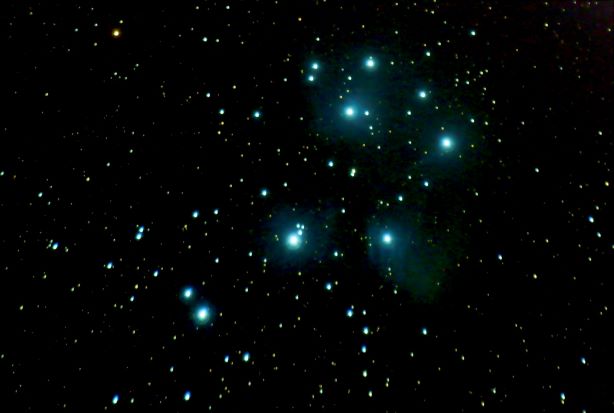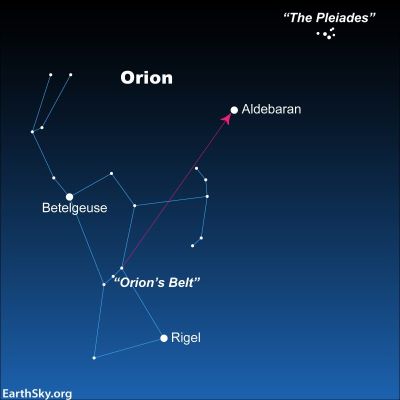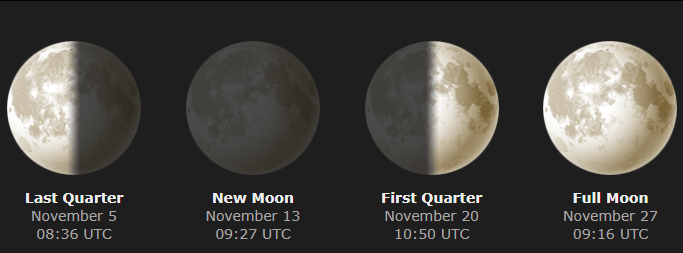This month I had wanted to focus on two of my favourite celestial objects in the night sky, but due to the risk of this Stella Cartography becoming too long, I have opted to focus on just the Pleiades and leave the Orion Nebula for a future edition.
The Pleiades is an open star cluster in the constellation of Taurus the Bull. Astronomers have determined that the cluster contains over 1,000 individual stars, although it is dominated by seven bright blue stars which have given the Pleiades one of its many names, The Seven Sisters.

The Pleiades is only about 444 light years away from Earth, which makes it one of the closest open star clusters to our planet and very easy to find and observe. The brightest star within the cluster is Alcyone, a blue-white giant star that is a similar age to the other stars in the Pleiades at around 115 million years old.
 The stars within the cluster all help illuminate a nebula (seen here in an image taken by my friend at the Boreal Edge Observatory in Canada), which for a long time was thought to be a remnant of the enormous gas cloud that created the stars themselves. Astronomers now consider this reflection nebula to be caused by an area of dust unrelated to the creation of the cluster, which the stars are traveling through and illuminating as they go, over time they will pass beyond that dust cloud and the nebula will fade.
The stars within the cluster all help illuminate a nebula (seen here in an image taken by my friend at the Boreal Edge Observatory in Canada), which for a long time was thought to be a remnant of the enormous gas cloud that created the stars themselves. Astronomers now consider this reflection nebula to be caused by an area of dust unrelated to the creation of the cluster, which the stars are traveling through and illuminating as they go, over time they will pass beyond that dust cloud and the nebula will fade. Over the next 250 million years, the cluster will continue to slowly move toward the base of the constellation of Orion, while the stars that make up the cluster will continue to spread apart, eventually breaking up the cluster as it is seen today.
What came first, the cluster or the name?
Trick question, of course, at around 115 million years old, the cluster certainly came first – but one of the interesting things about the Pleiades is the origin of its name. When it comes to the naming of constellations, planets, and other celestial objects, we are all used to hearing names that come from ancient Greek, Arabian, or Roman mythology and assume that the object was named in honour of that mythology. In the case of the Pleiades, however, it is now widely accepted that the mythology of the seven daughters of Atlas and Pleione called the Pleiades, was created specifically by ancient Greeks to explain the creation of the star cluster.
The name Pleiades is believed to have originated from the Greek word 'plein', meaning to sail. It is suggested that the Greek sailors may have named the cluster as they would observe its appearance in the sky during late spring and early summer, which signaled the start of the fishing season in the Mediterranean.
In popular culture

Due to the prominence of the cluster, it isn’t surprising that it has appeared in many genres of fiction over the years.
In Star Trek, the planet Valara III is located within the Pleiades and is visited by the USS Enterprise in the TNG episode Home Soil. The episode features a team of Terraformers who land on a planet in order to terraform it. However, their mission is threatened when they come across a new form of silicon-based life that is native to the planet. This new life form looks crystalline in structure and is named Microbrain (pictured here). After establishing communication with the life form, it becomes apparent that the planet is not lifeless. A brief battle ensues where the Microbrain is starved of light, but eventually a truce is declared. The Microbrain requests to be left alone for the next 300 years, after which it hopes that humanity will have evolved and be less primitive.
In The Lord of the Rings, J.R.R Tolkien took inspiration from the Pleiades and referred to them in the Fellowship of the Ring as “Remmirath” or the “Netted stars. In Chapter III, just as Frodo and the hobbits are making their way out of the shire, it is stated that,
Away high in the East swung Remmirath, the Netted Stars, and slowly above the mists red Borgil rose, glowing like a jewel of fire. Then by some shift of airs all the mist was drawn away like a veil, and there leaned up, as he climbed over the rim of the world, the Swordsman of the Sky, Menelvagor with his shining belt.
Here the red star Borgil is likely a reference to Aldebaran, and Menelvagor with his shining belt can only really be a reference to Orion.
One post of the Golden Gate of the Ecliptic.
The Pleiades, along with another famous open star cluster, the Hyades, form what has been described as the “Golden Gate of the Ecliptic.” The ecliptic is the invisible line that the Sun, Moon, and planets all appear to travel along as they cross the sky from East to West. The ecliptic's path is drawn between the two clusters, hence each cluster acting like a gate post.
Moreover, 5000 years ago the position of the solar equinox, where the Sun appears highest in the sky, was in the constellation of Taurus the Bull. This meant the Sun would have shone highest at the centre of the "Golden Gateway." This was clearly seen as important by early astronomers, so much so it is thought to have been recorded on the 4,500-year-old Sky Stone of the Tal-Qadi Temple in Salina, Malta.
How to find the Pleiades
 The easiest way to find the Pleiades is to use some natural signposts in the sky.
The easiest way to find the Pleiades is to use some natural signposts in the sky. Start off in dark skies and find the constellation of Orion the Hunter.
Go to his belt and follow that line of stars up from the lowest star to the highest.
From there follow that same line up until you come to a bright orange star which forms the eye of the Bull Taurus, that star is called Aldebaran.
From there continue to the line up a little further until you come to a dense collection of stars,
Congratulations you have arrived at your destination, can you make out all Seven Sisters?
The Moon
Here are the Moon’s phases during November, along with the dates.
• Last Quarter – 5th November
• New Moon – 13th November
• First Quarter – 20th November
• Full Moon – 27th November

November's full moon is known by many names such as the Beaver Moon, as it is believed that during this time of the year in North America, beavers increase their dam construction activity in preparation for winter. The Frost Moon is another name given to the full moon in November, as it marks the arrival of the first frosts of the year. However, the name that resonates with me the most is the Mourning Moon. I recently learned that this name originated from the pagans who spent the year making preparations for the winter season. MoonGiant.com goes on to say, “Practicing Pagans may perform a moonlit ritual where they write down the things, they want to rid themselves of and ask their Goddess for help in removing unwanted burdens."
Mercury
Mercury transitions into an evening planet this month, but early observations will be close to the horizon and in bright twilight. On November 14th Look to the Moon on the western horizon at sunset, to the right of the crescent, you may catch a glimpse of mercury. November 26th will be the first opportunity to see Mercury on the Western horizon after twilight (from about 5pm onwards.)
Venus
Venus is still a morning planet but is now starting to sink lower in the morning sky as it passed its greatest elongation in late October. Look to the East before dawn and you really can’t miss her shining close to the binary star Spica in the constellation of Virgo. Venus has begun her journey back to being a night-time planet.
Mars
Mars is currently impossible to view as it passes directly behind the Sun from us. We will see the red planet again in the New Year.
Jupiter
Jupiter is visible all night and is the brightest planet in the evening sky. November is a great time to spot Jupiter as it sits below the constellation of Aries the Ram, very close to the Pleiades in neighbouring Taurus, just follow the steps above to find the Pleiades, and Jupiter will be that incredible bright star shining just to the right of that. Jupiter reaches Perihelion, the point where it is closest to the Sun, on the evening of the 1st of November. At Perihelion Jupiter will be approximately 370 million miles away from the Earth, with Jupiter reaching opposition (where is it directly opposite the Sun in relation to us) on the 2nd of November – this means it will be closer, bigger and brighter than at other times of the year, a perfect time to pop out and admire the King of planets.
Saturn
Saturn is still sitting very close to the constellation of Aquarius in Southern Skies after dark, but as we get deeper into November the planet will be getting closer and closer to the horizon, eventually setting before midnight at month’s end. A lovely bright planet in the south, well worth a pair of binoculars if you have them.
Uranus
Uranus is reaching opposition this month, where the Earth is directly between the planet and the Sun, meaning that Uranus will be at its brightest, which sadly for Uranus at over 1.89 billion miles away, isn’t very bright at all. You will still likely need binoculars or a small telescope to make out the pale green dot, as it rises in the East at the same time the sun sets in the west. Look to the constellation of Aries and good luck!
Neptune
Neptune is so far away it doesn’t really move very much (relatively speaking) so appears in the same patch of sky every night this year. Look between Aquarius and Pisces and he’s there somewhere… you’ll need dark skies and a good online planet finder though.
Thanks to
Much of the research in this month's edition came from several sources including BBC Sky at Night Magazine, EarthSky.org, MoonGiant.com and Wikipedia.
Next Month’s Preview
Next month, Stellar Cartography will look at the December skies, including some of the astronomical theories behind the Christian story of the star of Bethlehem.
What did you think of this edition of UFP Stellar Cartography? Let us know in the comments below.
WRITTEN BY WoorLord
EDITED BY WoorLord
IMAGES SOURCED FROM Wallpaper Mania - Pintrest.co.uk - Boreal Edge Observatory - Shutterstock - Memory Alpha - MoonGiant.com


